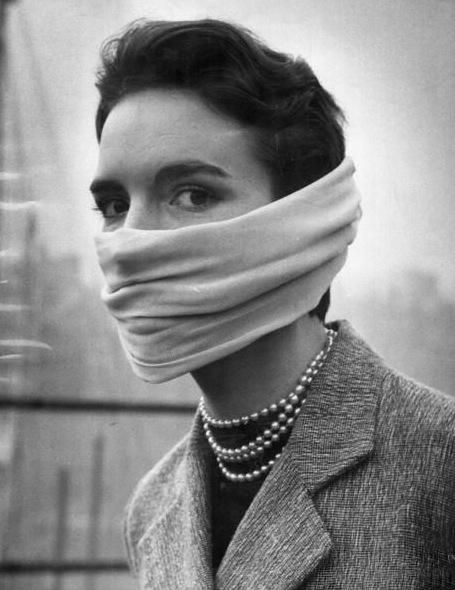
The model Julie Harrison
On Saturday 6 December 1952 the performance of La Traviata at Sadler’s Wells was abandoned at the interval. The incessant coughing of the audience had become intolerable due to the dense ‘pea-souper’ smog which had been slowly creeping into the auditorium making the stage almost invisible to the people who had sat further back.
Further west across London the greyhound racing at White City was halted when the dogs couldn’t see the hare, and reportedly a Mallard duck flying blindly across London smashed into Victoria station and crash-landed onto platform 6.

Before the dense fog had enveloped London the weather for the previous few weeks had been colder than normal. Houses throughout the capital, in those pre-central heating days, were burning large amounts of coal in a million fires and stoves – all of which were emitting a particulate-ridden sulphurous acidic smoke.
Although it had been cold, the weather had been relatively fresh and clear but by Thursday 4 December the conditions began to worsen. The breezes stopped and the skies became greyer and the atmosphere noticably dank.
By the next day the whole city had started to appear like a scene from Dickens’ Bleak House:
Fog everywhere. Fog up the river, where it flows among green aits and meadows; fog down the river, where it rolls defiled among the tiers of shipping, and the waterside pollutions of a great (and dirty) city…Chance people on the bridges peeping over the parapets into a nether sky of fog, with fog all round them, as if they were up in a balloon, and hanging in the misty clouds.
The fog on that Friday morning was thicker than anyone could remember even by people who had long considered the London smog just another aspect of living in the capital. Incidentally the portmanteau smog was coined only forty five years earlier, by HA Des Voeux, who first used it in 1905 to describe the conditions of fuliginous (sooty) fog that occurred all too often in the capital city.
The unpleasant impermeable fogs had been a feature of London for centuries and it wasn’t just Dickens who wrote about, as he would call it, the London Particular. Descriptions of the London fogs can be found in the Sherlock Holmes’s stories and in Louis Stephenson’s Dr Jekyll and Mr Hyde. The mythical quality of the London fog was reflected in practically any Hollywood film set in London even many years after the era of the London ‘pea-soupers’ had passed. Indeed the great smog of 1952 was the beginning of the end of the eye-stinging London Particulars.

By nightfall on Friday 5 December the smothering fog thickened and visibility in most of London dropped to a few metres. During the next day the sun was too weak and low in the sky to make much of an impression on the fog and that night, and on the Sunday and Monday nights, it again thickened. In most of London it was almost impossible for pedestrians, totally disorientated through lack of familiar landmarks, to find their way home.
Because of the dirt and the vile, clogging, unpleasant taste of the smog, many people held ‘masks’ of gauze, scarves or handkerchiefs to their faces. On the Isle of Dogs, almost surrounded by the Thames, visibility was occasionally officially reported to be nil – the fog was so dense that people could not see their own feet.
Hospitals were soon filled with patients suffering from acute respiratory diseases and, almost un-noticed, deaths in the city began to mount. No one noticed at first until undertakers started to run out of coffins and florists were running out of flowers. The very ill weren’t helped by ambulances searching in vain for victims and clanging their bells frantically while unable to extricate themselves from the snail-paced traffic jams.
This London smog, compared with a normal fog or even other urban smogs, was especially lethal after the war because it contained high quantities of sulphur oxides from the cheap sulphurous coal (the better quality hard coal was being exported) that reacted with the moisture in the air to produce a diluted, but lung-corrosive, sulphuric acid mist. The killer brew, to some people, triggered massive inflammation of the lungs – in other words thousands of people were dying almost through suffocation.
The British Committee on Air Pollution finally estimated that during the five days that the smog smothered London there were 4,000 more deaths than would have occurred under normal circumstances. During the next two months it was thought another 8,000 deaths were caused by a direct result of the killer smog. Even during the next summer the death rate was 2% higher than normal.
Legislation followed the Great Smog of 1952 in the form of the City of London (Various Powers) Act of 1954 and the Clean Air Acts of 1956 and 1968. These Acts banned emissions of black smoke and decreed that residents of urban areas and operators of factories must convert to smokeless fuels.
Nothing on the scale of the 1952 Great Peasouper has ever occurred again and it remains the nation’s worst single air pollution disaster. There has been an astonishing hundred-fold reduction in atmospheric particulate levels in London over the last fifty years and the air, in most respects, is cleaner in the capital city than at any other time since the middle ages.
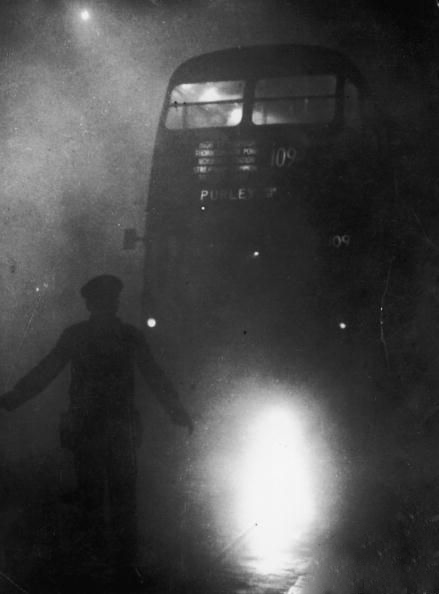
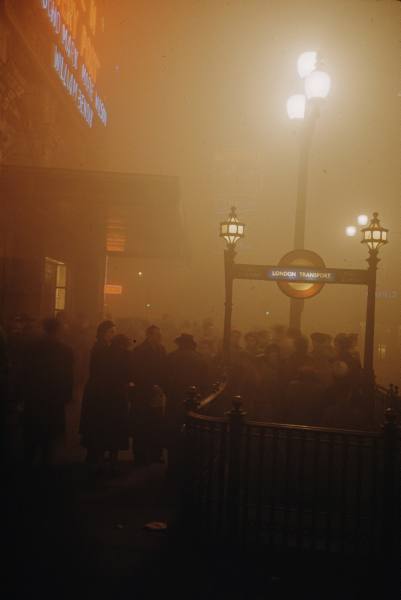
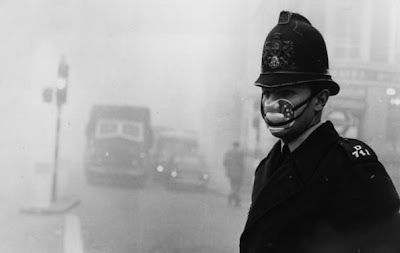



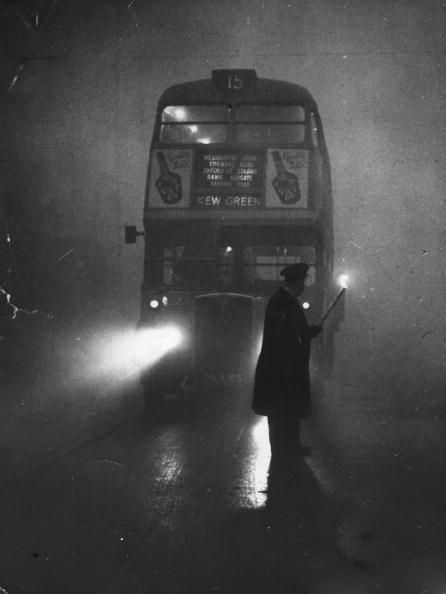
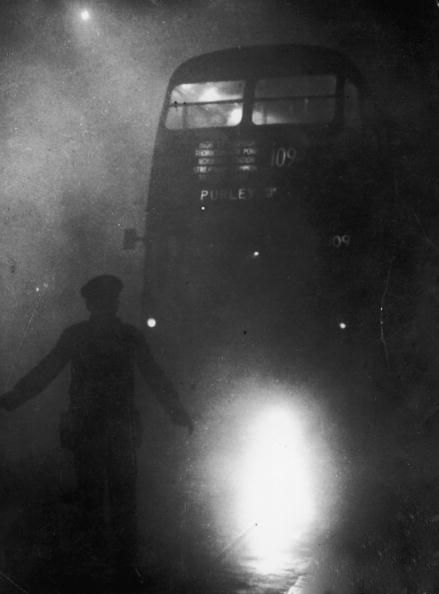

What an incredible set of photographs. I thought for a moment I was looking at prints from one of those early British science fiction movies, like the Quatermass Experiment.
There is such a wealth of interesting information (and one hopes film footage) top be had from this decade, that I’ve never understood why more creative use was never made of it in terms of the cinema and television. The British, it would seem, still have an unquenchable appetite for watching Jack Hawkins and John Mills chasing German U-boats across their Sunday morning TV screens.
To me, the 1950s have been the great “lost opportunity” as a resource for new works. I think that’s certainly the reason people like myself find this blog in particular so appealing. Where else can you find stuff like this?
once again .. well written, well research story.
Great story and photos too. Your blog is totally awesome and I am so glad I found you through “I’m Learning To Share!”
Sublime photos, chillingly evocative.
love those vintage old-timey fog stills, so haunting.
Just included a link to this post at the Pop Culture Institute… Love love love the photos, and I agree that there’s so much out there sitting in file drawers that needs to be put on the Internet, especially from the 1950s and before.
I was looking for a picture of Mandy R.-D. for a comment of mine and found a set of very fine ones here.
This smog contribution is even more smashing – the environment fanatics of today can get an impression, what air pollution really is. Impressive photos! Thanks!
[...] See smog [...]
really what was the aftermath of the london smog disaster. and some of the images of this. If you could help me out that would be really great. I thank you for your time
sarah wilson
skyview highschool
I was 5 at the time, but still have vivid memories of that smog: yellow writhing snakes that crept indoors so that sitting at our table you had a blurred view of the coal fire.
My great-grandfather died as a result of a chest infection (his lungs had been damaged by gas whilst serving in the army during the First World War). I remember us visiting him whilst they had him in an oxegen tent, thne looking out the window and seeing – nothing.
Although thgings improved it was not until the mid 60′s that it was just fog rather than smog.
When it was smog there were tims when you had problems seeing your own hands when held in front of you.
These pictures took me back to my childhood in the 60s, when you literally could not see yours hands in front of your face, the smog was so thick. Loved the photos. They reminded me of some of those early scifi films in the 50s.
I would like permission to use two photos for an educational exhibit on air sampling machines. To whom can I address this request?
Thank you.
Stephen Horne
I was born on 5th December, 1952. My mum had a rotten time when she was in labour, because a man had to walk in front of the ambulance to make sure they didn’t hit anything. Apparantly every couple of minutes he would bang on the front of the vehicle to say move ahead about 6 ft. Eventually I was born on the steps of St. Mary’s Paddington,(or at least my head was). Mum said I was put in an incubator. I was probably the only person in London enjoying fresh air.
holy cow,i never even heard of that smog in 1952.12.000 people killed.man that is a disaster.
Forgot.
let´s hope this will never,ever happen again.
We have to take more care so this won´t happen again.
Very nice photos =).
Fascinating photos. The 1952 smog had a huge impact on my life’s direction. I was only a baby, born in London in 1951, but the smog led my dad to decide to migrate to Melbourne, Australia, which we did in 1954. My mother, Olive Turner, was a Londoner (Iverson Road, West Hampstead – the cottages are still there, I believe) and my dad, Loreto, was a Maltese member of the Royal Air Force stationed in London. (He changed his name to York after the War). Anyhow, my mother, and my father, both told me how he decided then and there, horrified by the smog and its affect on me as a baby, that we’d be going to Melbourne where he had a brother who worked on the wharves.
I wonder if others emigrated for similar reasons? Was I among the first of the “eco-refugees”?!
The good news, of course, is that we humans can conquer these kinds of problems.
These pictures bring back many memories for me. I was 20 years old in December 1952 and working in London, near Victoria Station, and living in South London (Lewisham). When I left work on that first night there was no transport running and a group of us banded together and walked to Lewisham using the tram lines as our guide as we could not see more than a foot or so ahead of us. It took ages – and when I finally reached home (after a long slow walk) I found the fog had even seeped into the house. I can still remember the awful taste it left in your mouth (a sort of sulphurous taste) and the dreadful smell the fog caused. Thank goodness such a thing cannot happen in London again.
Hi there, there really are some fascinating personal stories on here. I work as a freelance broadcast journalist and am currently researching a project about the Great Smog of 52. I’m particularly interested in getting in touch with the author of this article as well as a number of the people who have commented on it to see if they would be interested in being interviewed? At this stage I just need an expression of interest in the project but would love to speak with Chrissie Fryde, Geoff Boxell & Marion. You can get in touch at c.hamilton.86@hotmail.co.uk
Fascinating. An elderly couple we met on holiday in Dec 2010 told my wife and I about the 1952 fog. They were young then. Their families moved out of London (Brixton) as a result. I had never heard of this story beforehand and decided to research the fog on our return from holiday. The gentleman put the figure of casualties at 25,000 and claimed that government records were sealed for longer than normal in an attempt to conceal the scale of the fog’s impact.
Hello!
I’m a journalist at the Environmental Research Group (ERG) at King’s College London currently working on a slideshow featuring information about the history of air pollution in London.
I’d like to request your permission to download and use the pictures of smog for this project.
If permission is granted, copyright will be acknowledged.
Thank you!
[...] image sourced from “Another Nickel in the Machine“ This entry was posted in Boris Johnson, greater london authority, London Organising [...]
Hey there, I have a similar request to the journalist up there.
I’m a student studying Graphic Design, and our current project is to create a pretend magazine about a certain decade. (My decade is the 50s.)
It would be terrific if I too could have permission to use your photographs in it, rather than having to create my own fake ones in Photoshop. And yes, they would be referenced.
Thanks
Remember it well. I was 8 living at 389 The Highway, Stepney. Walked right into a bright red post office box because I could not see it
Incredible photographs, I was born at Lambeth Hospital,Brook Street. My family, who walked from Brixton to visit me, became lost for hours at the oval. They said they had stood behind a tea vendors hut for a good hour before realising it was even there, apparently the smog not only diminished visibility but deadened sound. My Mother said that in hospital the smog managed to get in through air vents etc. I will now show these photographs to my Mother, thanks so much.
οικοζην,oikozin…
[...]A Proper Pea-Souper – The Terrible London Smog of 1952[...]…
My parents moved house from London NW2 to Crawley in Sussex on Monday 8 Dec 1952. We children went with them. I recall sitting in the cab of the removal van as it drove slowly through London. I was 10 yrs at the time so have no memory of the route we took. I do however recall arriving at our brand new house in Crawley, constructed by Crawley Development commission. It had no heating that night.
My Dad’s brother was killed in the smog of 1952. Until seeing these photos I couldn’t imagine what it was like – thanks for telling the story.
Really great photo’s but I was born in 1961 and remember being in my pushchair and my Mum apologising to people as she waked into them with the pram I was probably about 2 but I remember not being able to see anything, you could not see your hand in front of your face so those fogs didn’t vanish over night.
I think that comment that London has clearer air now than since the middle ages is incorrect. We may not have the cheap coal fires anymore but we have many more millions of people in London now and many more cars, air conditioners, various heating vents, aeroplanes going over London, constant building work going on etc how could it be cleaner than the middle ages?
That is ridiculous. Whenever I manage to get out ofLondon you can immediately feel how much easier it is to breath and someone I know who has just moved to London says he wakes up with dirty fingernails in London.
Just read some of the other comments I used to live on the Highway in Shadwell E.1 as well but later in 1980 in a tower block when I was young and first married we had a bad fog one night. My husband was out I awoke to a banging on the bedroom window which scared me as we were on the 13 th floor. Turned out to be birds probably sea gulls banging into the windows because they couldn’t see the tower block in the fog. My father was hospitalised for months in 1955 aged 18 for TB which was a lot more common then, I’m wondering if this was connected to the smog problem in London?
[...] More Share on Twitter [...]
My family came to London in 1957 and I remeber the London Smog very well.
You could follow your own sister home thinking it was the girl next door. It was really bad, although nothing like the 1952 Smog. It’s the first time I have heard of it.
Thank God this will never happen again – the majority of factories have been moved out of London and no one burns coal in fireplaces anymore thus no chimneys to release fumes into the atmosphere.
[...] photos from London smog of 1952. Wrong weather + burning coal = big problem for London.” The photo page on Nickel in the Machine is dated 2008, so not sure why Ancestry has flashed it up now, but good to [...]
I need to know what happened to wild birds, caged birds and animals curing the Great Smog of 1952. How many pets died? They must have been legion.
This is a wonderul site.
As an eight year old kid in the big smog, it was fun, fun, fun!
And all the brightly polished silver in our house went black. The reaction between silver and the hydrogen sulphide(?) in the smog.
I was 14 and living in a back street in Wimbledon. It is an inner London suburb, and away from town centre there was little or no disturbance by moving traffic to thin out the dense fog in our residential roads. The result was that visibility could be down to a metre or so in the daytime. Walking out of doors became a matter of shuffling my feet to feel for road kerbs, etc. This was made even worse at night because each back street lamp at the time was fitted with an incandescent light bulb which gave no penetrating light onto the pavement my to see my feet, or even the lamp post! Fog penetrating fluorescent lamps did not become widely available until later on in the Fifties.
I went to the local Odeon cinema on the second day and was hardly able to see the screen. It closed the next day. ‘Smog masks’ were sold out by the fourth day. My asthmatic uncle, Percy Spink, died in a north London hospital, a victim of the smog. It took my Dad 4 hours to get to his bedside through the gloom. He was too late.
We lived by a railway and there were frequent bangs near to signal stands beside the track. These explosions were made by percussive caps (Fog Signals) and were placed on the track to warn drivers that they were slowly approaching a signal, and that they were to stop the train and peer out at the signal through the gloom before they could proceed or not.
When the smog eventually cleared away there was a black-grey covering of slimy soot particles on all of the top surfaces out of doors. This sooty grime stayed there until a few days later when the first rains came. This soot covering was then washed off the surface of evergreen leaves, buildings and pavements, etc, into gutters and down the drains in dirty black rivulets. The pungent smell about in the atmosphere was of acrid wet soot, which made my eyes and nostrils smart as I walked down Queens Road on my way home.
I was born in inner London in 1952. I was told that I had many illnesses when young, like most children. Our immune systems were stuffed. I can remember being a 3 year old in Regents Park not being able to see my aunt who was only feet away and crying because she had run away. When I returned home after my “healthy” walks, I had to be scrubbed down as I had a layer of crud on my face. I do vividly remember the smell of rotten eggs in the air and yellow everywhere. I had trouble breathing and constant bleeding noses. My parents finally moved me to Bucks in 1957 so that I could have a healthier life. I don’t think it dawned on them what really caused the health problems.
In 1958 after my parents divorced I came to Australia where my mother came from and settled into a healthy life. My lungs have never fully recovered from the damage done in my childhood and digestion problems remain. My nose continued to bleed regularly for decades. I know that other people who were born in that filthy city in the 1950s have similar problems now.
Pollution destroys people no matter what governments try to tell us. We must clean up our global act!
I am now 60 and
,
My Dad still recalls one night in very heavy and thick fog as they tried to drive back home, he found it impossible to drive, and had my mum to walk along the kerb so he could follow her. Yes there must be more to improve the environment, in the 1840′s the stink from the river Thames prompted the great sewer building by Bazelgette that ultimately helped clean up London but poured London’s wasted out east into the ocean. More recently this has been corrected and the waste is now processed. Like the smoke free restriction in London to help reduce the smog it seems we also need a crisis in order to act. Can’t we learn from these lessons
On a Radio 4 Fact File recently the presenter interviewed one of Boris Johnson’s assistants to discuss the fact that these lorries were going around at night spraying the roads near the most congested areas that give off the worst pollution readings in the UK, (near the Marylebone Road), so that it may reduce the readings that are above the levels set by the EU. When the interviewer asked him outright whether the system was in place to fiddle the readings rather than help reduce pollution he couldn’t, like a true politician, just say ‘no, of course not.’
Hello.
I am working on an educational movie about air quality research for NASA. The movie is going to include a historical perspective. I am wondering how and where you got permission to use the images in this post so I can get permission to use some of them as well.
Please let me know, if you don’t mind.
I appreciate your time.
Izolda
Hello,
I am another person making a request for the permissions to use these images or to whom I can address for permissions?
Any help would be much appreciated.
Thanks,
Rupert
My father student at the Royal College of Music recalls that week of smog, saying that cattle in Covent Garden had dropped down dead and movement in the city was impossible.He was also informed during a lung check quite recently that there was definite old scarring on his lungs. The Specialist asked my father whether he had been in London 1952 and of course he confirmed that he was….
Very interesting brought back some memories. I was 10 that year and fully recall trying to go to school, must have been the first day. Despite a flashlight in hand it was very difficult to walk the few hindred yards to the bus stop and when the bus did eventually appear it was a sort of surreal sight with the very orange yellow headlights grasping through the smog, I seem to recall that the conductor assisted the driver in navigating, Not only was vision impaired but there was a silence across the world which seemed to absorb all sounds.
This was by no means the only smog I remember, my father had a car that the windscreen opened on and there were a number of ocassions in my early life that we children sat in the back with the windscreen open and my mother shouting instructions and using a flashlight to see the curb. Great fun but a cold experince…no heaters in that vehicle.
With respect to the history of air quality in London this may have been the apex of pollution but it went back hundreds of years there even being a statute in the city from think the early 1300s banning/controlling sea coal (presumaly coal from NE England brought by ship) because of air pollution issues. It maybe the first ever clean air act even. Things clearly got worse till the 60s when the new acts really kicked in. Anyone who lived through it knows that modern cars are a minor source compared to those days.
Out of interest for those who haven’t experienced fog or smog, it cuts out most sound as well, making it very eerie.
I am an English teacher from Madrid. I’m taking a course about GOTHIC LITERATURE and today we have read the beginning of Bleak House by Dickens, which starts: “Fog everywhere. Fog up the river…” and describes a magical London. Then the professor told us about the pea souper and showed us these wonderful photos published in The Daily Mail. They are absolutelly beautiful and so evocative for literary creation. Then at home I found useful information about this event in this blog. Beautiful photos, interesting research. Congratulations!
[...] and soot. When you see the dense thick texture of the pe soup, you can understand the term! It was this smog in 1952 that led to legislation to help cut pollution. See the video below to see what it was really [...]
I grew up pre-war near an industrial area of Manchester, where there were many similar choking green-yellow smogs, the only form of transport being trams preceded by the conductor carrying a kerosene flare, followed by cars, which finished up at the tram depot! The Clean Air Act cleaned up this local pollution, but the building of coal-fired power stations in East Anglia dumped acid rain over northern Europe, destroying many forests. Now we have the much more serious problem of atmospheric pollution with carbon dioxide, through prodigious combustion of fossil fuels for energy supply, leading to global warming and climate disruption, which threatens the future of our own species, biodivesrsity and the biosphere as a whole
Does your site have a contact page? I’m having problems locating it but, I’d like
to send you an email. I’ve got some recommendations for your blog you might be interested in hearing. Either way, great blog and I look forward to seeing it expand over time.
[...] “A Proper Pea-Souper – The Terrible London Smog of 1952.” Another Nickel in the Machine. 22 Nov. 2008. Web. 20 Feb. 2013. [...]